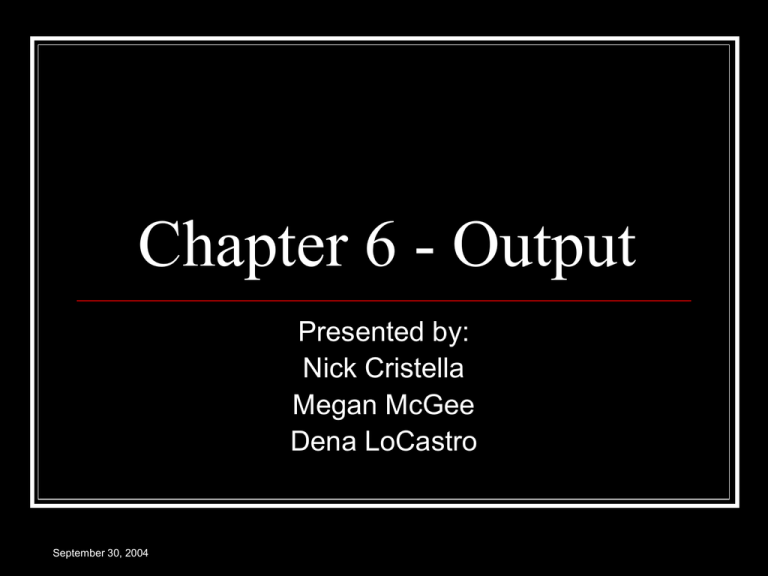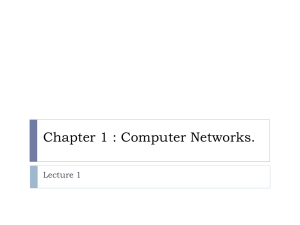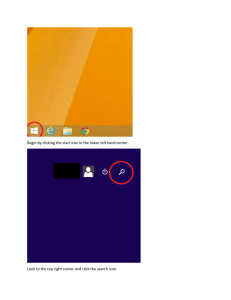Chapter 6 - Output Presented by: Nick Cristella Megan McGee
advertisement

Chapter 6 - Output Presented by: Nick Cristella Megan McGee Dena LoCastro September 30, 2004 Overview of the Presentation Introduction to Output Display Devices Cathode Ray Tube Monitors Flat Panel Printers Audio Output Devices Other Output Devices September 30, 2004 Introduction to Output What is Output? Categories of Output Output: the result of data being processed into something usable. Text Graphics Audio Video Additional Vocabulary September 30, 2004 Text Text: documents are composed primarily of words and numbers. Examples of text documents: Memos Letters Reports Advertisements Newspaper Books September 30, 2004 Graphics Graphics: added to a document to assist in understanding and to enhance the aesthetics. Examples: September 30, 2004 Clip Art Photographs Charts Animation Audio Audio: sounds or music used to enhance a presentation or another document. Examples: Games Music Research Programs Websites September 30, 2004 Video Video: the mixing of sound and moving picture to assist in understanding. Examples September 30, 2004 Video Games Movies News Clips Websites Additional Vocabulary Output Device: any item that conveys information to one or more persons. Examples: Television Speakers Computer Monitor September 30, 2004 Display Devices Introduction to Display Devices CRT Monitors Quality Video Cards Flat Panel Displays Technology Video Cards Gas Plasma Monitors September 30, 2004 Television Introduction to Display Devices Display Device: a method of visually presenting text, graphics, and video. Soft Copy: items on the display device that are only there temporarily. Monitor: a plastic or metal casing that protects the display device Monochrome: displays in one color Gray Scaling: displays in black, white, and grays. September 30, 2004 CRT Monitors CRT: Cathode Ray Tube Similar to a standard television, mainly because it uses the same CRT technology. September 30, 2004 Video Cards Video Card: (a.k.a: graphics card) changes digital computer output into an analog signal to send it to the CRT monitors. Bit depth: number of bits the card uses to store information concerning each pixel. September 30, 2004 Flat Panel Displays LCD Monitor: a monitor that uses a liquid crystal display instead of the cathode ray tube. It takes up much less desk space then a CRT monitor. Nit: unit of visible light that is equal to one candela per square meter. Candela: standard unit of light intensity. September 30, 2004 Video Cards and LCD Monitors DVI (Digital Video Interface): Where the LCD monitor plugs into the computer. S-Video Port: where one can connect outside devices such as a TV or DVD player. September 30, 2004 Gas Plasma and HDTV Gas Plasma: display using gas plasma, which uses a layer of gas for the liquid crystal. HDTV: Uses digital broadcasting signals, using digital sound, and supporting a wide screen. Interactive TV: a twoway communications system where users can interact with the programming. September 30, 2004 Games Voting Printers Printer: an output device that puts visuals on a physical medium, such as paper. There are two ways to orient a document on a page Portrait: taller than it is wide Landscape: wider than it is tall There are many different types of printers available today: Impact, Dot-Matrix, Line, Non-impact, Ink-Jet, Photo, Laser, Thermal, Mobile, Label, Large-Format, and Wireless. September 30, 2004 Impact and Nonimpact Printers Impact: forms visuals on a document by actually striking a mechanism against the ink ribbon that hits the paper. Can be very noisy Produces near letter quality (NLQ) output, which is slightly less than what is acceptable for business letters. September 30, 2004 Nonimpact: forms visuals, but never actually touches the paper. They either spray ink, or use heat and pressure. Most printers are nonimpact in present day. Types of Impact Printers Dot-Matrix: produces images by striking tiny wire pins against an ink ribbon. Line: a high speed impact printer that prints one line at a time. September 30, 2004 Ink-Jet Printers Ink-Jet: a nonimpact printer that prints by spraying tiny drops of liquid onto the document. September 30, 2004 Prints letter quality (LQ) Printer resolution is measured in dpi (dots per square inch. Bubble Jet: Ink-jet printer that sprays the ink through tiny nozzles. Photo Printers Photo Printer: a color printer that produces pictures that are on the same quality level as lab photos. Can print any size and can even be printed on paper that feels like a photograph. September 30, 2004 Laser Printers Laser Printer: high speed, high quality, nonimpact. Uses software that allows them to interpret page description language (PDL). PDL: tells the printer how to lay out a page. Prints using a laser and a powdered ink, or toner. September 30, 2004 Thermal Printers Thermal Printer: creates images by pressing hot pins against heat sensitive paper. Thermal wax-transfer: creates images by melting wax onto heat sensitive paper. Dye Sublimation: uses heat to transfer colored dye to specially coated paper. September 30, 2004 Mobile and Label Printers Mobile: a small printer that is battery powered and can accompany a laptop computer. Label: small printer that prints on an adhesive paper. Postage: a label printer that has a digital scale to print postage. September 30, 2004 Plotters and Large-Format Printers September 30, 2004 Plotter: printers that are made to print specialty prints, such as blueprints and maps. Large-format: Printers that are large enough to print high quality posters, signs, etc. Speakers and Headsets Audio output device: part of a computer that produces music and other sounds. Speakers and headsets are most common. Speakers have two parts to them Woofer: enhances bass Tweeter: enhances higher noises September 30, 2004 Headsets allow for audio where a speaker is not practical, such as in a lab, or in a crowded space. Voice Output: when you hear a person’s voice or when the computer verbally communicates to the user. Fax Machines Fax Machine (short for facsimile machine): an output device that sends and receives data over telephone lines. A fax is the document being transmitted. This requires a fax modem, which allows a computer to send or receive faxes. This can be an internal or external device on the computer. September 30, 2004 Multifunction Peripherals Multifunction Peripheral: a single machine that has the capabilities of a printer, scanner, copy machine, and a fax machine. Sometimes referred to as all-in-one devices. These are also used by small offices and home offices, because they take up considerably less space. September 30, 2004 Data Projectors Data projectors: a device that uses the image from the computer screen and projects it onto a larger screen for an audience. There are two types. September 30, 2004 LCD: uses liquid crystal display technology. DLP: digital light projector. It uses tiny mirrors to reflect images clearly, even in a well lit room. Accessories Joysticks and wheels use force-feedback technology to do their jobs. They uses the movements of the user to send resistance and simulate real-life experiences. September 30, 2004 The End Chapter 6 – Output By Megan McGee Dena LoCastro Nick Cristella September 30, 2004


